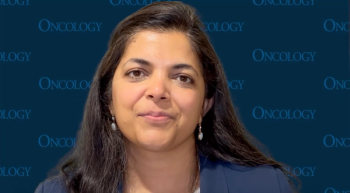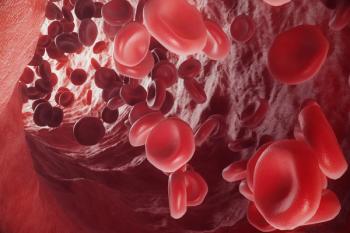
Oncology NEWS International
- Oncology NEWS International Vol 19 No 3
- Volume 19
- Issue 3
Follicular lymphoma: Is watchful waiting still a treatment option in era of new and improved therapy?
In asymptomatic disease, overall survival is often the same with immediate treatment vs watch and wait. The deciding factor may be what patients are willing to tolerate.
ABSTRACT: In asymptomatic disease, overall survival is often the same with immediate treatment vs watch and wait. The deciding factor may be what patients are willing to tolerate.
New therapies for follicular lymphoma, including rituximab (Rituxan), have led to improved outcomes but have also fueled a controversy: Is it still appropriate to withhold treatment early in the course of disease?
Four experts debated the watch and wait approach at ECCO/ESMO 2009 in Berlin. But reading between their stated positions, it was clear all of the participants agreed that watchful waiting is appropriate for some low-risk patients. However, those who took the "con" position set the bar much higher to determine who qualifies as low risk.
The standard for asymptomatic patients
Despite what drug companies would have people believe, there is not always a sense of urgency when it comes to treatment, said Michele Ghielmini, MD, from the Oncology Institute of Southern Switzerland in Lugano. "Marketers would like to sell you these new drugs today, but follicular lymphoma remains an incurable disease, even when treated with the five most potent drugs available plus stem cell transplant and rituximab," he said. "You can watch and wait and then catch up later with chemotherapy and stem cell transplant."
Median survival after diagnosis of follicular lymphoma is 12 to 15 years. One argument for starting therapy immediately is that delaying therapy will lead to problems such as irreversible organ damage, resistant disease, transformation, and less robust response to delayed therapy.
But Dr. Ghielmini argued that these fears are unfounded. Organ damage is very rare in follicular lymphoma. The key is to take the "watch" part very literally, following patients closely and often. Regarding resistance and transformation, response rates are not influenced by tumor stage, he said, adding that in one study, the reported incidence of transformation in 600 patients was only 3% per year (J Clin Oncol 26:5165-5169, 2008).
"Side effects of therapy are not increased when you delay therapy," he said. "The majority of side effects, including alopecia, nausea, and infection, depend on the drug itself and are not influenced by disease stage."
Advantages of waiting include delaying acute and late adverse effects of therapy and delaying impaired fertility. Perhaps the most important point is that there is no survival difference in patients who are managed by watch and wait vs upfront treatment, according to three studies (Semin Hematol 25 (suppl 2):11-16, 1988; J Clin Oncol 15:1110-1117, 1997; Lancet 362:516-522, 2003).
"Thanks to rituximab, follicular lymphoma has an improved prognosis. Nevertheless, starting therapy immediately in asymptomatic patients anticipates toxicity without improved survival," Dr. Ghielmini said.
Criteria for management
Philippe Solal-Celigny, MD, from the Centre J. Bernard in Le Mans, France, also spoke in favor of watchful waiting. He agreed with Dr. Ghielmini that asymptomatic patients have to be carefully followed, including a visit to the hematology clinic every three months.
He explained that at his institution, "we take a moderate position. We believe that not all patients need to be treated initially. We use several criteria to decide which patients should be managed by watch and wait."
For stage I disease, excisional biopsy is curative and patients can be observed after surgery, Dr. Solal-Celigny said. The watch and wait strategy is appropriate for patients with stage I or II nonbulky disease (< 5 cm) in a site with a high risk of radiation treatment toxicity, such as the mediastinum or peritoneum. It is also appropriate for elderly patients with comorbidities, he added.
Watchful waiting can also be done in patients with stage III-IV low-risk disease (FLIPI-1), who have a 10-year overall survival (OS) of 71%, and in patients who are at intermediate risk (no more than two adverse events) and have nonbulky disease.
"I believe that watch and wait is the best way to manage all low-risk patients and some with intermediate risk, that is, those with moderate bone marrow involvement and high beta-2-microglobulin," he said.
Dr. Solal-Celigny acknowledged that for the strategy to be successful, patients have to be willing to accept watchful waiting without feeling abandoned or anxious. To optimize a watch and wait strategy, the patient should have a good relationship with his or her doctor, live near a hematology center, and be aware of the warning signs and symptoms of disease progression.
"The best way to select patients for watch and wait is to do so three years after diagnosis. If they progress within six months, you know the tempo of the disease, and you can initiate therapy as it is required," he said.
Targeted Rx improves overall survival
Martin H. Dreyling, MD, from the University Hospital Grosshadern in Munich, argued in favor of early treatment in the majority of asymptomatic patients. In the pre-targeted therapy era, patients with high tumor burden had no difference in OS with immediate or delayed treatment, he said.
Recent studies have shown that targeted therapy improves OS. Christian Buske, MD, PhD, and colleagues showed that progression-free survival (PFS) was improved by 10% with the addition of rituximab to CHOP vs CHOP alone in 200 patients with follicular lymphoma (ASH 2006 abstract 2599). A separate meta-analysis by Holger Schulz, MD, and colleagues showed that the addition of rituximab treatment with targeted therapy improved OS (J Natl Cancer Inst 99:706-714, 2007). Five-year OS was improved by more than 20% with early targeted therapy (J Clin Oncol 26:1582-1589, 2006).
In patients with low tumor burden, Dr. Dreyling said that five randomized trials found no difference in OS between observation alone and early treatment with chlorambucil. More recent data show that newer drugs and radioimmunotherapy can improve response rates and achieve durable remissions for up to five years (N Engl J Med 352:441-449, 2005).
"Quality of life is important, and keeping patients in remission for as long as possible optimizes quality of life," he said. "With targeted therapy, survival is improved and quality of life is good. There is no reason for watch and wait. In the U.S., one survey showed that only about 19% of oncologists watch and wait" (J Clin Oncol 27:1202-1208, 2009).
'Wait and worry' for patients
"Wait and watch means wait and worry for patients," said Eva Kimby, MD, from the Karolinska Institutet in Stockholm. "There are too few clinical trials, with a small number of patients, to help us make this decision. In the trials that have looked at watch and wait vs early treatment, we don't know how long the watch and wait period was before these patients entered the trials. Potential benefits of early therapy include improved disease-free survival and OS, but have yet to be proven with the new targeted therapies."
Follicular lymphoma has no curative therapy and is characterized by multiple relapses. Dr. Kimby advocated close follow up of patients and initiating therapy at progression and not waiting until bulky disease. Achieving complete remission is associated with longer PFS, independent of type of therapy, she added, and "patients who respond to therapy have durable remissions."
These patients should get the best available therapy, she said. "Why identify patients according to risk if you are not going to treat the ones who are high risk?" she asked.
Articles in this issue
over 15 years ago
Final-Phase Trial Underway for Everolimus in Gastric Cancerover 15 years ago
Soy foods may reduce recurrence risk in breast cancer patientsover 15 years ago
Single-shot Zevalin presents new lymphoma Rx optionover 15 years ago
Biomarkers signal true progress in war against lung cancerover 15 years ago
Heart transplant patients face greater risk of skin cancerover 15 years ago
Effective Rx for KRAS-mutated colon cancerover 15 years ago
Pilot programs drive change in healthcare delivery modelNewsletter
Stay up to date on recent advances in the multidisciplinary approach to cancer.
















































































